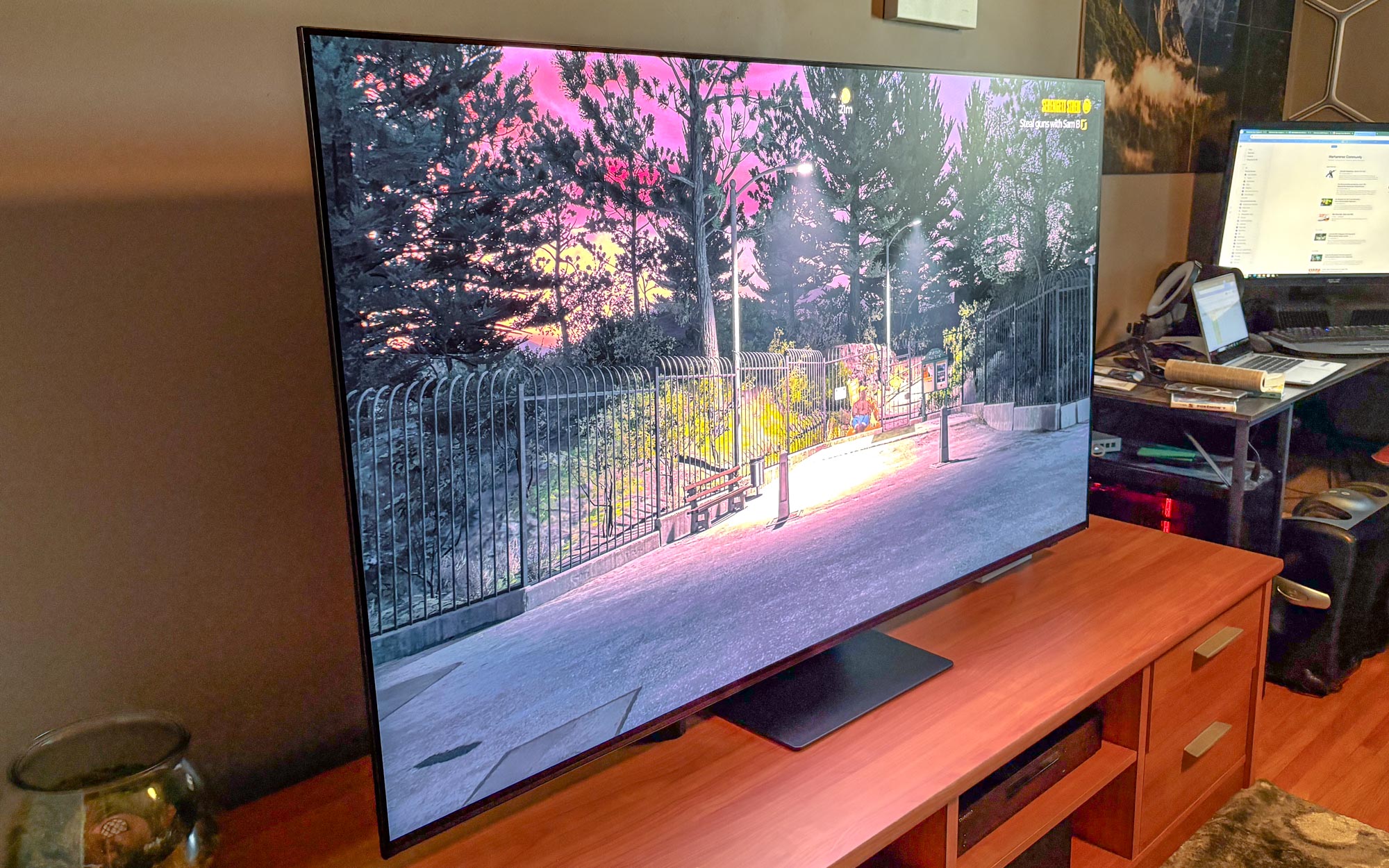
For years, OLED TVs have been plagued by glare, often relegating them to rooms where no light can reach. The Samsung S95D OLED, however, is here to change that. You can put this TV in a bright room — even near a window — and still enjoy a vibrant picture, whether you’re watching the big game or a dragon turn a prospective rider into a burnt marshmallow.
To wit, this is one of the first TVs we’ve seen to almost completely eliminate glare, and it does it without taking a hit to its brightness output or color vibrancy.
Not only is the Samsung S95D’s screen well-designed, but so is its internal hardware. It’s a TV that is made for folks who love to endlessly tinker with settings — and for everyone who hates tinkering with settings, too. That’s a confusing statement, almost contradictory, but there’s so much you can customize on the S95D it’s easy to forget that you can lean on Samsung’s built-in NQ4 AI Gen2 processor to do it all for you. The results are wildly impressive with a few notable exceptions that I hope will be patched in a future firmware update.
So why doesn't the S95D get a full five-star rating? Its picture quality certainly places it among some of the best TVs we’ve tested, but there are some issues that are hard to ignore. Chief among those problems is its motion processing that creates blurring and artifacting — an issue that I’ve had with Samsung TVs for the better part of the last decade — and its overprocessing of some scenes. When the S95D comes down in price for Black Friday these issues won’t be so glaring, but at its launch price of $2,597 ($2,297 after some recent discounts) every detail matters.
Samsung S95D OLED review: Price and release date
The Samsung S95D OLED is Samsung’s flagship 4K OLED TV for 2024. It sits above the Samsung S90D and competes with some of the best OLED TVs from Sony and LG like the Sony A95L OLED and the LG G4 OLED.
As you’d expect from its luxury looks and strong specs, the Samsung S95D isn’t cheap. Here’s a list of its current prices in all available sizes:
- 55-inch QN55S95DAFXZA: $2,599 | $2,297 on sale
- 65-inch QN65S95DAFXZA: $3,399 | $2,899 on sale
- 77-inch QN77S95DAFXZA: $4,599 | $4,099 on sale
So how do these prices compare to last year’s Samsung S95C OLED? They’re very close — the S95D is $100 more at launch but, with discounts, it’s almost evened out. That being said, you can find the 55-inch S95C on sale now for $1,499, so if you don’t need the anti-glare filter, you can save big by buying last year’s flagship instead.
Not sure which size screen you should buy? Check out our ‘What size TV should you buy?’ guide. No matter which you choose, you should expect to see similar performance to our 65-inch test model. All sizes offer the same collection of ports and Samsung’s NQ4 AI Gen2 Processor.
Samsung S95D OLED review: Design
The Samsung S95D OLED goes for minimal bezels and, thanks to the OneConnect Box that can send power and HDMI data via a single cord, minimal wires as well. Inside the box you’ll find two different lengths of wire for the OneConnect Box cable: a small 6-inch wire that has just enough length to reach from the box on the back of the TV to the OneConnect port on the TV itself and a longer wire of roughly five feet that you can use should you decide to wall-mount it.
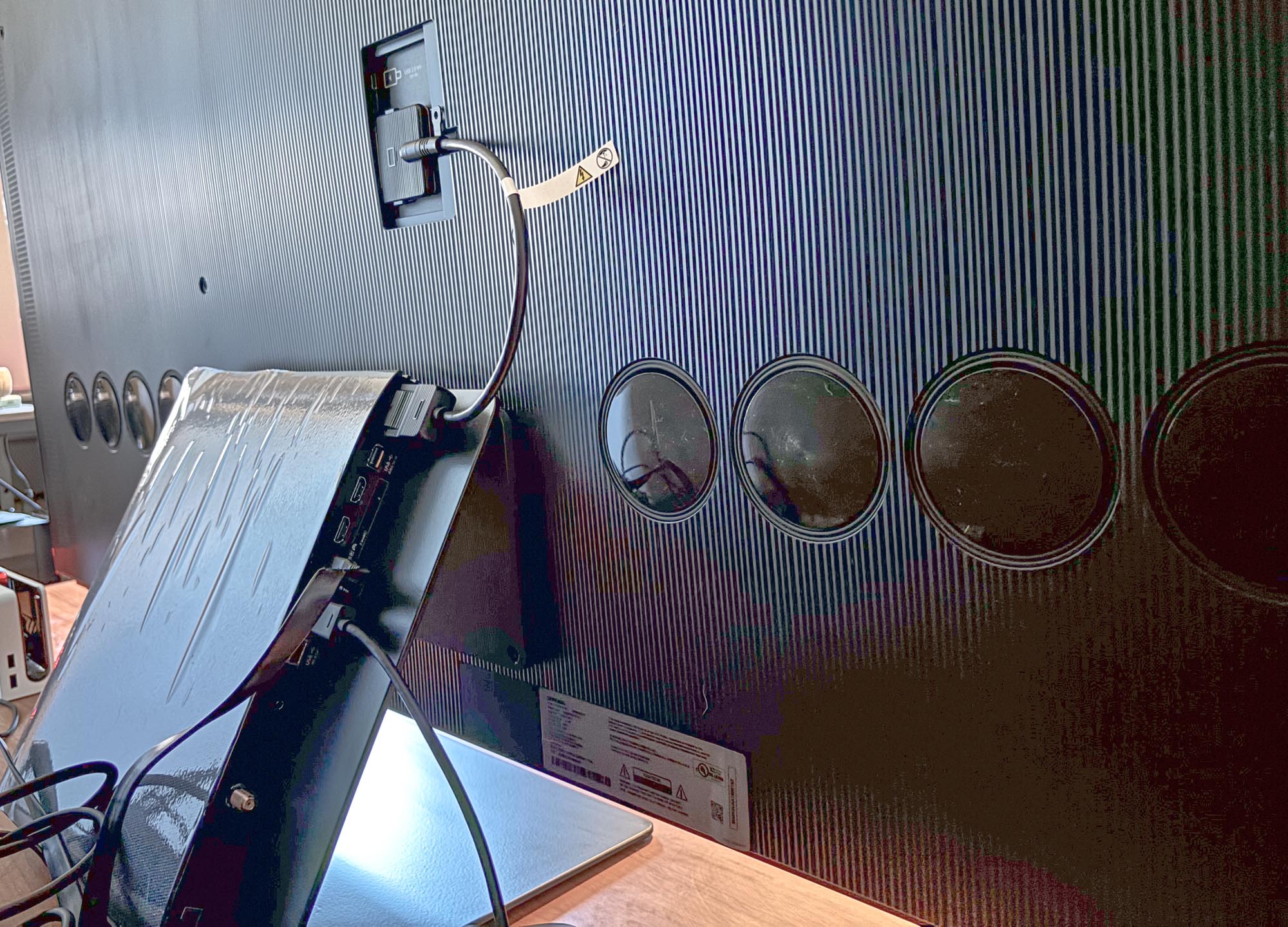
Speaking of wall-mounting, given that this TV is 0.4 inches from front to back, it’s going to look incredible when it’s wall-mounted. To do so, you can use any old 400 x 300 VESA wall mount, but to get the optimal picture-on-wall effect where the TV sits perfectly flush, you’ll have to shell out a bit extra for the $159 Full-Motion Slim Wall Mount from Samsung.
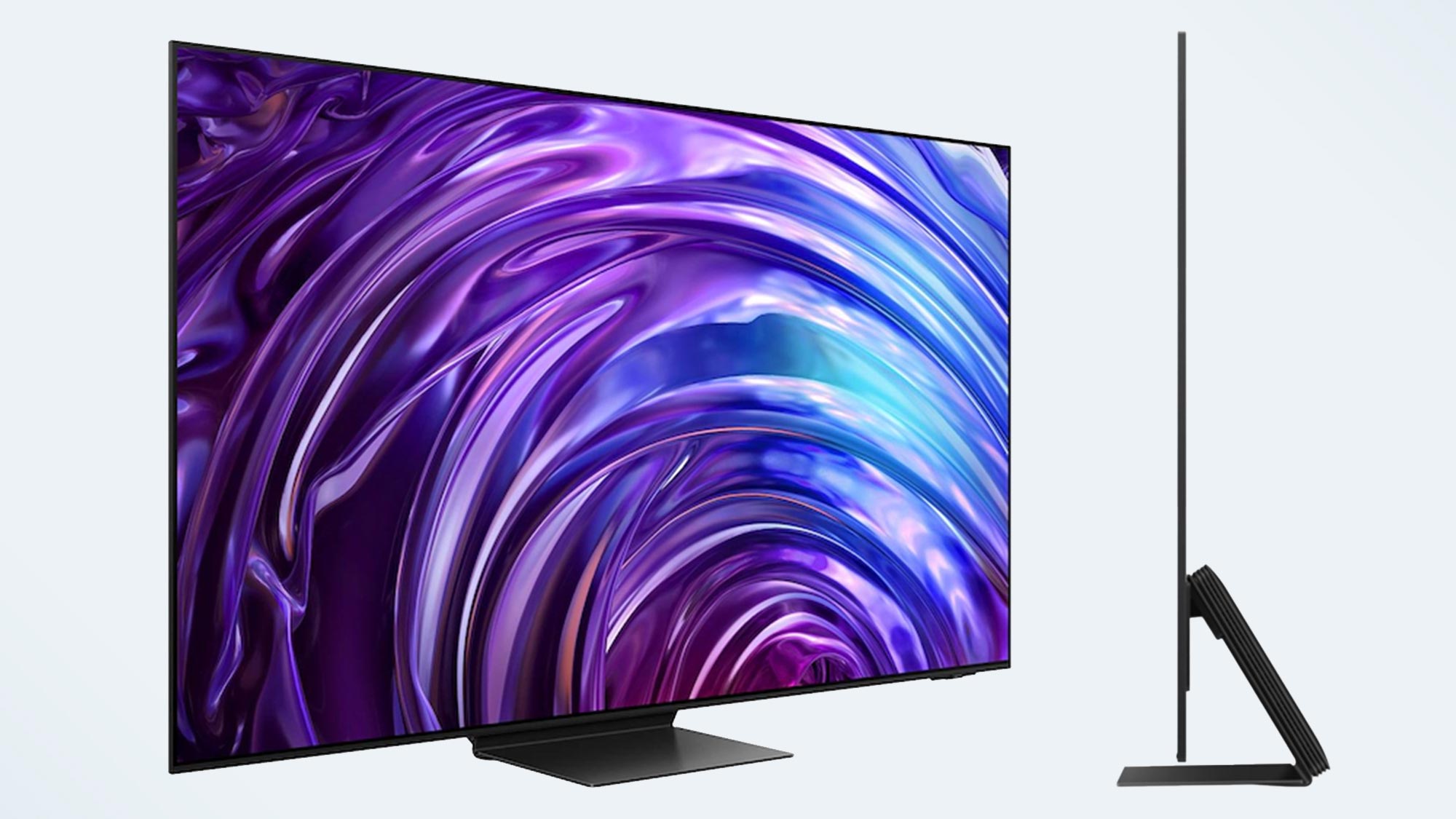
While the design of the TV itself is well-engineered, the screen’s fragility can make setup can be a bit perilous, especially if you’re trying to do it all by yourself. I enlisted some help to do the actual lifting and carrying of the screen, but getting the stand to fit perfectly took around 15 minutes and a lot of patience due to some of the screw holes on the stand not being perfectly aligned with the heavy base.
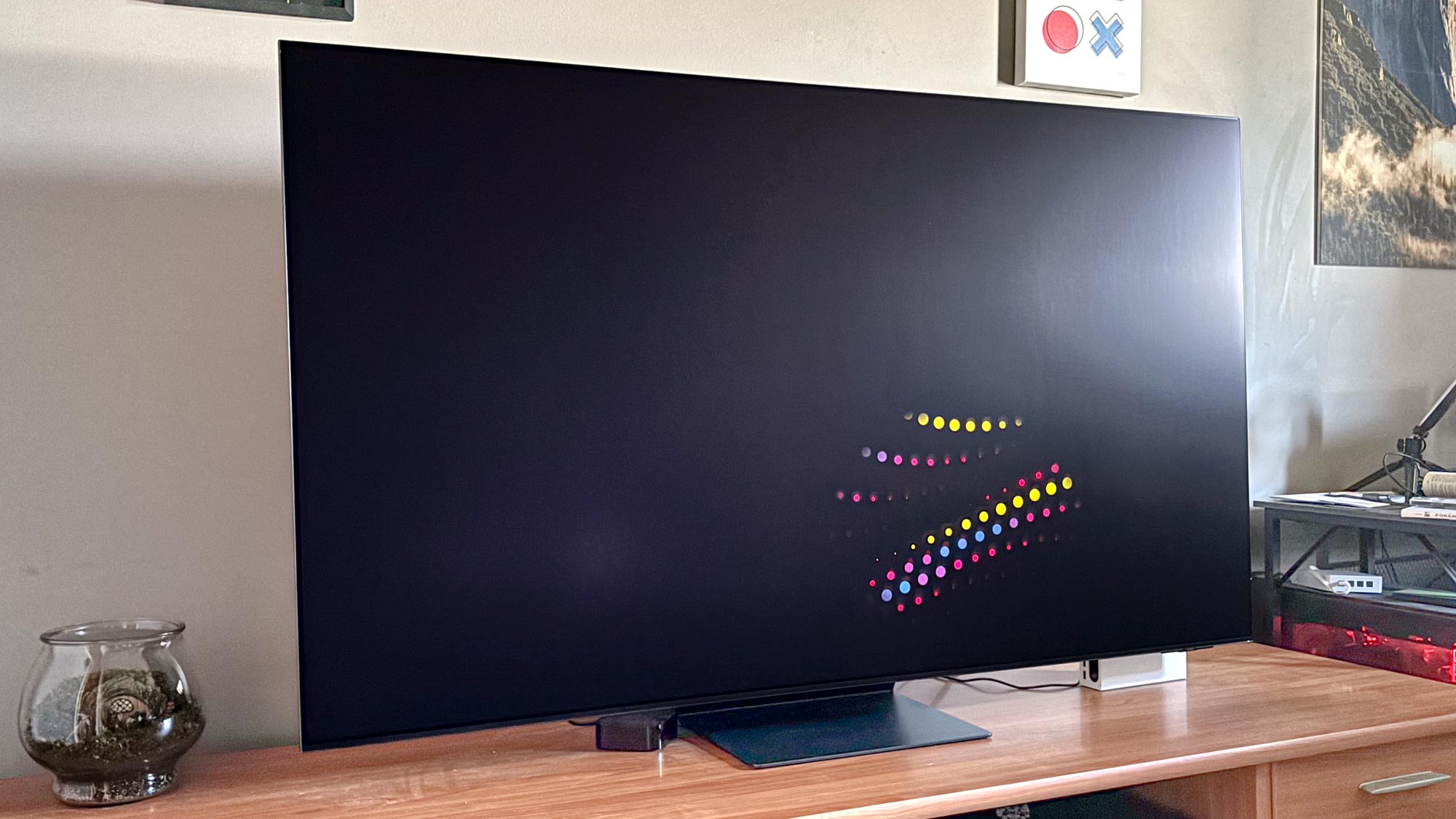
Once it’s set up the TV feels secure, but it requires a steady hand as its glass front could crack if you accidentally apply too much pressure when lifting it from the floor to your entertainment center.
Overall, the Samsung S95D has a beautiful look thanks to the lack of cable-clutter, but the ease-of-setup could still be improved in next year’s inevitable Samsung S95E OLED.
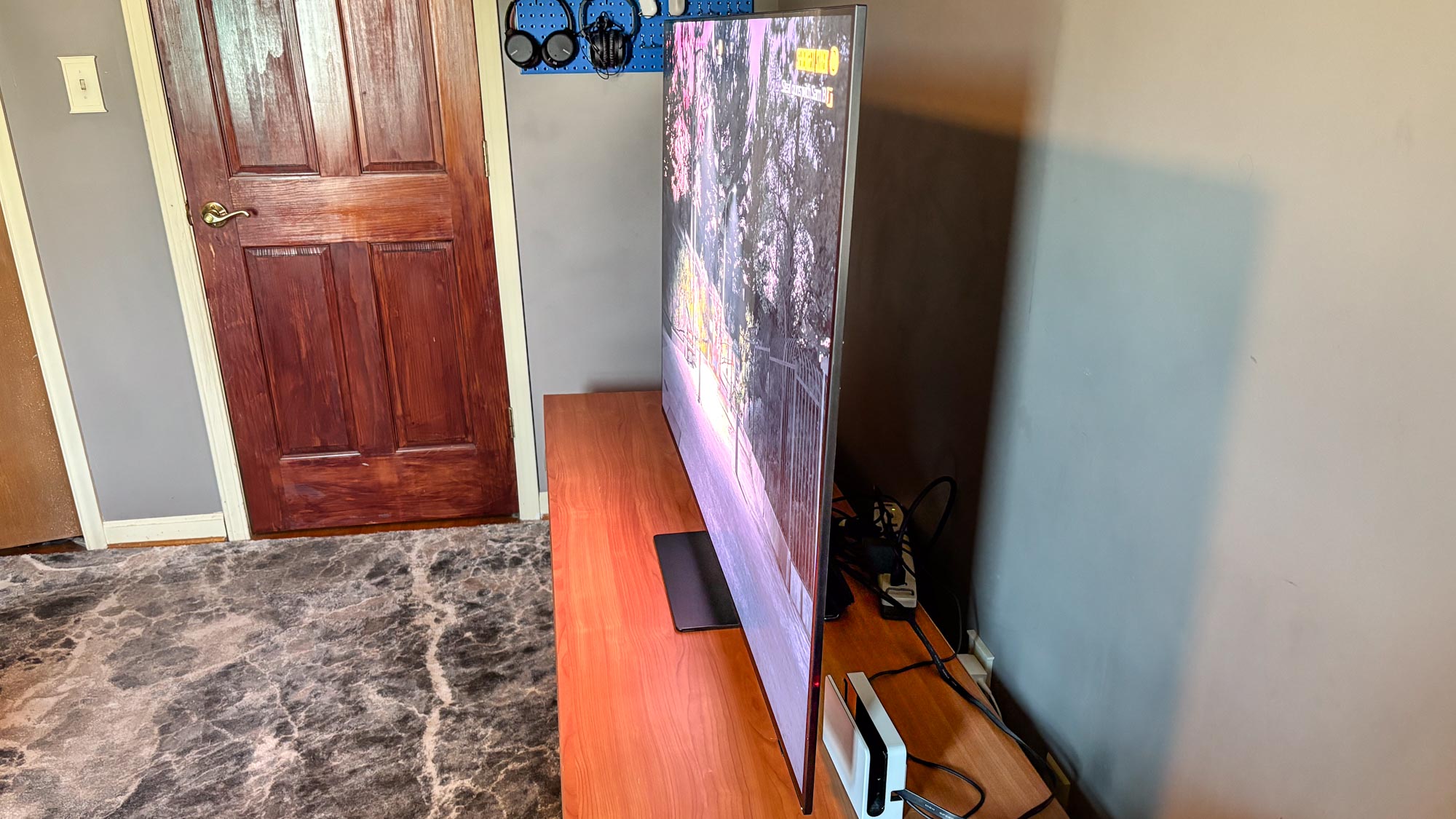
Samsung S95D OLED review: Ports
Unlike other OLED TVs that have HDMI cords jutting out from all angles, the S95D contains the mess with the OneConnect Box. As its name suggests, the OneConnect Box takes all the inputs and outputs to and from the TV and sends all that data through a single cable to the display itself. The box itself can sit on the backside of the screen or you can tuck it somewhere out of sight and just run the one cord to the TV itself.
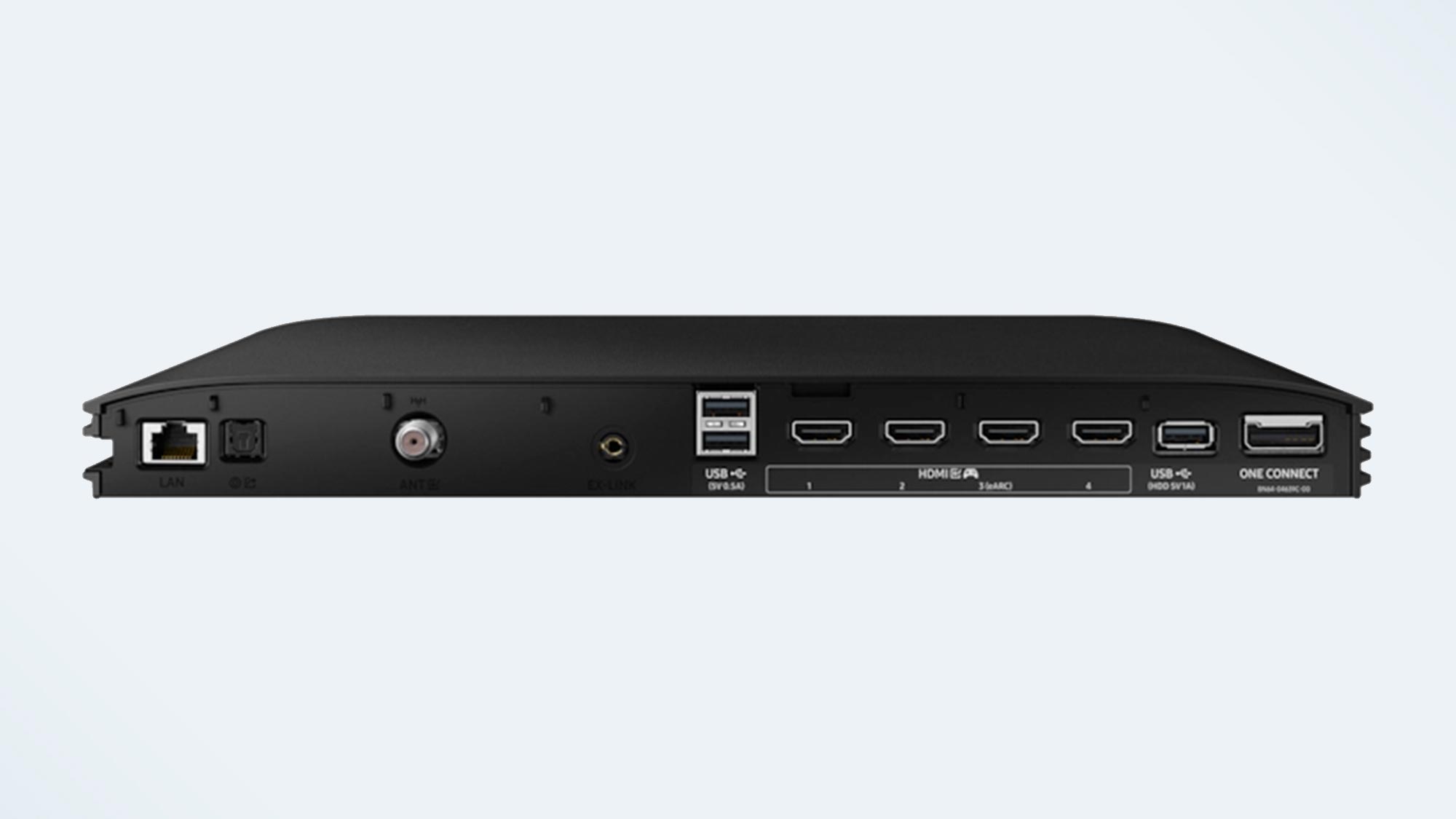
In terms of actual connections on the box itself, you’re looking at four HDMI 2.1 ports — one of which supports eARC — as well as an RF input, three USB ports, Ethernet port and Optical audio out. It’s a good selection and more than enough to connect all of the latest consoles, a gaming PC and a 4K Blu-ray player.
Samsung S95D OLED review: How we test
We follow a standard testing protocol for every TV we review at Tom’s Guide. Our benchmarks include a series of technical and subject tests designed to rate the set’s performance. For our technical tests, we use an X-Rite i1 Pro spectrophotometer, a SpectraCal VideoForge Pro pattern generator, and Portrait Displays’ Calman TV-calibration software to take measurements.
We also use a Leo Bodner 4K Input Lag Tester for determining the TV’s gaming prowess.
Subjective tests vary based on the reviewer, but usually feature anecdotes from a diverse selection of movies, TV shows, and other content reflecting the types of things you may actually want to watch on the TV. For a more detailed look at what we do and how we do it, check out our “How we test TVs” page.
Samsung S95D OLED review: Performance and test results
To put the Samsung S95D OLED through its paces, I tried a variety of content — everything from older HD/SDR movies like The Men Who Stare at Goats from 2009 to the newest episodes of House of the Dragon streaming from Max and The Acolyte streaming on Disney Plus in 4K/HDR. For the most part, images that were upscaled looked stunning and content that were already shot in 4K/HDR were displayed in dazzling colors on the anti-glare screen — though some were a bit over-processed for my taste.

But let’s start with the good news first. Color saturation and contrast are off the charts. In Filmmaker Mode, our preferred mode for testing, we measured the Samsung S95D’s color saturation to be 99.97% of the UHDA-P3 Color Gamut and a near-record-breaking 89.73% of the Rec2020 color standard. That’s a huge feat, and it makes HDR content — like the scenic vistas of Westeros in House of the Dragon — look jaw-droppingly gorgeous regardless of whether I left the blinds opened or closed in my office. (Thanks, anti-glare filter!)
The scenic vistas of Westeros in House of the Dragon looked jaw-droppingly gorgeous, regardless of whether I left the blinds opened or closed. Thanks, anti-glare filter!
That said, setting the S95D to Filmmaker Mode does come at the cost of brightness levels. In SDR, the OLED peaks at 276 nits in Filmmaker Mode and 1,780 nits in HDR. Those numbers, measured via an X-Rite i1 Pro spectrophotometer, a SpectraCal VideoForge Pro pattern generator, and Calman calibration software, are lower than what we’ve seen on the LG G4 OLED, the Samsung S95D’s biggest rival with the same picture settings. There’s not a massive difference, but it’s different enough that you’d be able to tell the difference between them.
In our other tests, the Samsung S95D fared OK — nothing to write home about, but nothing to complain about either. Its Delta E score that measures color accuracy right out of the box — with lower scores being more accurate than higher scores — was a 3.51. Samsung’s own testing put that number closer to 0.8, but that likely comes down to the differences in software versions between when we tested in March and when they tested in June.
Motion processing has always been a tricky one for Samsung to get right, and while the results are better here, I still think there’s room for improvement. Fast-moving objects, whether that was a character running in The Acolyte or a dragon flying across the screen in House of the Dragon had some motion artifacting. This wasn’t the biggest issue (we’ll get to that in one second) but you’ll still absolutely want to go into the “Picture Clarity'' settings and turn on Clear Motion.
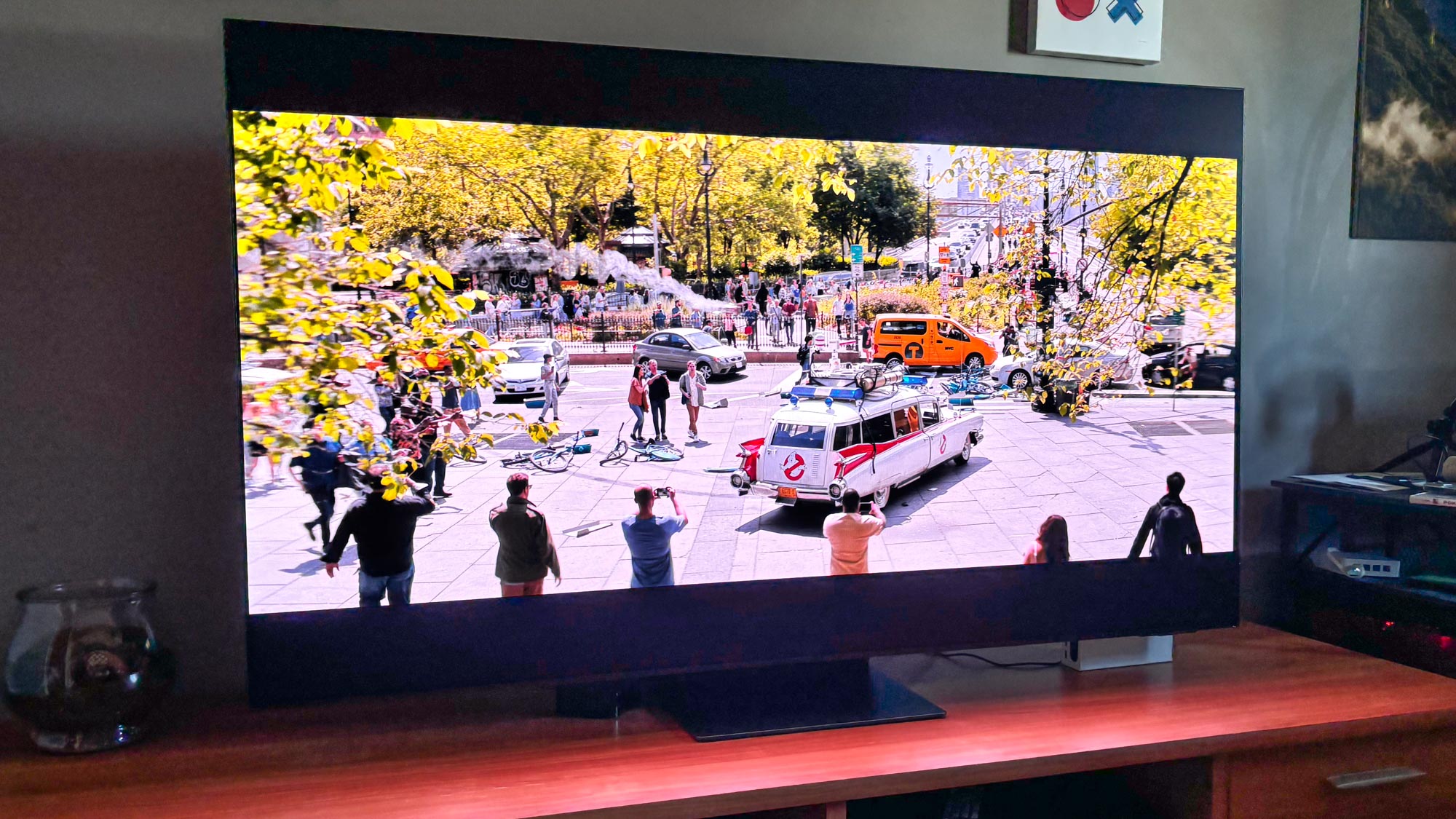
So what’s the deal with over-processing? Over-processing is essentially taking elements of a picture like objects in the foreground or background, and either oversharpening them or oversaturating them, sometimes both. An example that I encountered while testing happened in House of the Dragon’s season opener where torches on the back of castle walls became as bright as the sun in daylight shots. Clearly, the processor saw the flame flickering in the background, thought it was an important detail, and boosted the brightness and saturation. The result, however, was an almost epileptic pulsing that made some scenes uncomfortable to watch.
The overprocessing will always be a your-mileage-may-vary situation. Sometimes, it will be distracting, other times it will be helpful. You can, of course, turn off the AI processing (called Intelligent Mode in the settings) off entirely, but that would mean missing out on the worthwhile benefits that the NQ4 AI Gen2 processor brings to the table.
Samsung S95D OLED review: Audio
Of course, AI processing doesn’t just bolster the picture — it vastly improves the audio quality as well with dialogue being especially clear with AI processing turned on. There’s also a surprising amount of head room in volume. I found a volume level of 18 (out of 100) to be more than enough to fill a small room with detail-rich dialogue.
Producing all this sound is a 70W 4.2.2 speaker system that’s built into the TV. As with other multi-channel audio systems with built-in height channels (the final .2 of this system), I didn’t find that they added much dimensionality to the soundstage — despite trying several films with Dolby Atmos soundtracks — but I do think the overall sound is better than most TVs in its class.
If you want to tweak the immersiveness of the audio, it’s worth having a play around in the settings to see if you can get Samsung's Object Tracking Sound+ (OTS+) tech to form a more comprehensive bubble of sound or, even better, tack on one of the best soundbars to get a sound quality that’s commensurate with the S95D’s picture performance.
Samsung S95D OLED review: Gaming
While I didn’t have a powerful-enough gaming PC to test out Samsung’s 144Hz claims firsthand, I spent plenty of gaming time using my Xbox Series X. The three games in my current rotation are Tekken 8 and Dead Island 2, both of which were great tests for the TV’s low input latency I mentioned earlier, and the ever-relevant Red Dead Redemption 2 that I could use to test the limits of the S95D’s HDR performance.
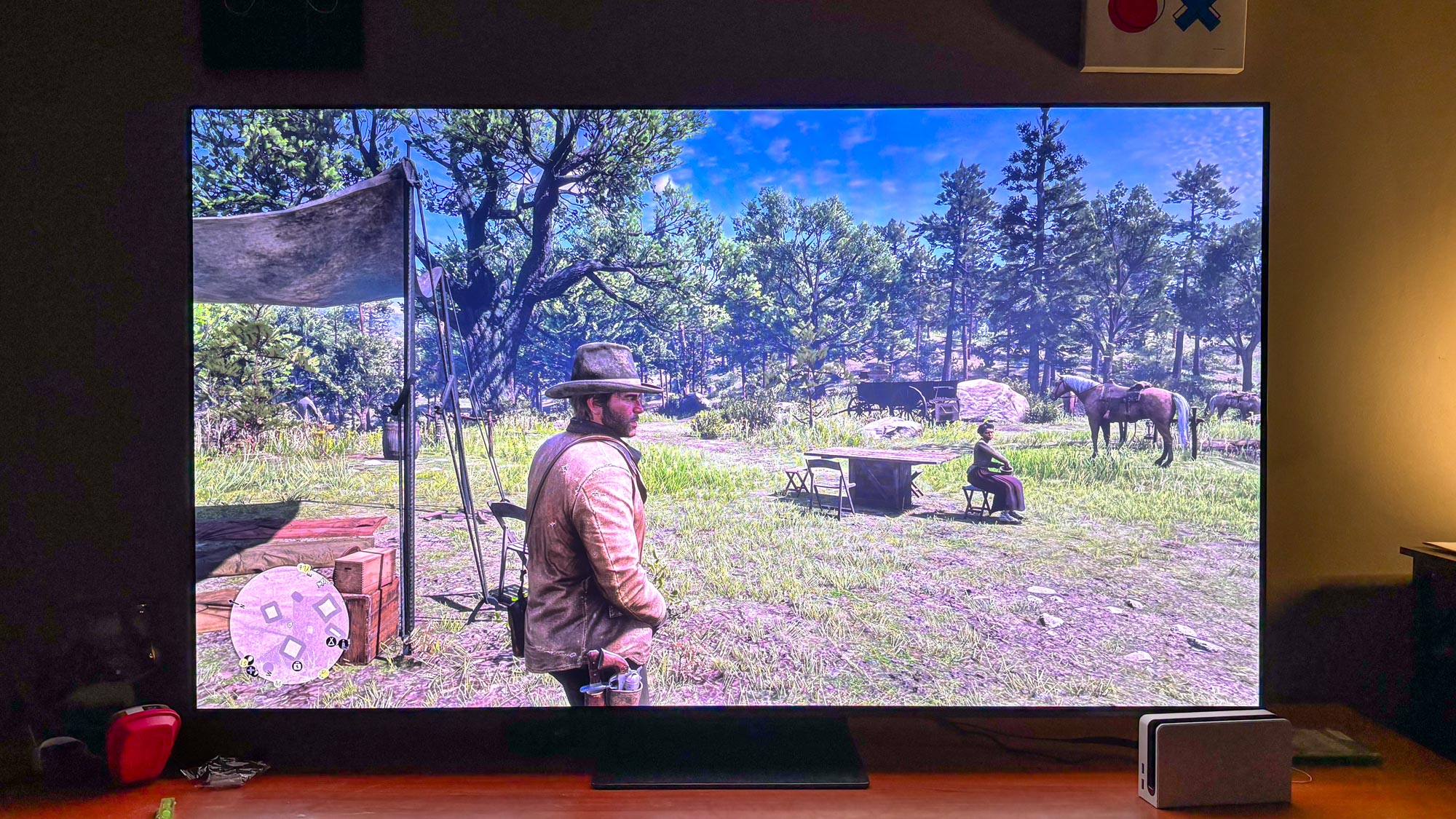
Unsurprisingly, the S95D didn’t disappoint in any of the three titles. The sprawling plains and snow-capped mountains of Red Dead Redemption 2 were the prettiest I’ve ever seen them look on the S95D, and thanks to Auto Game Mode and VRR support, Tekken 8 and Dead Island 2 had absolutely no screen tearing or motion artifacting to speak of.
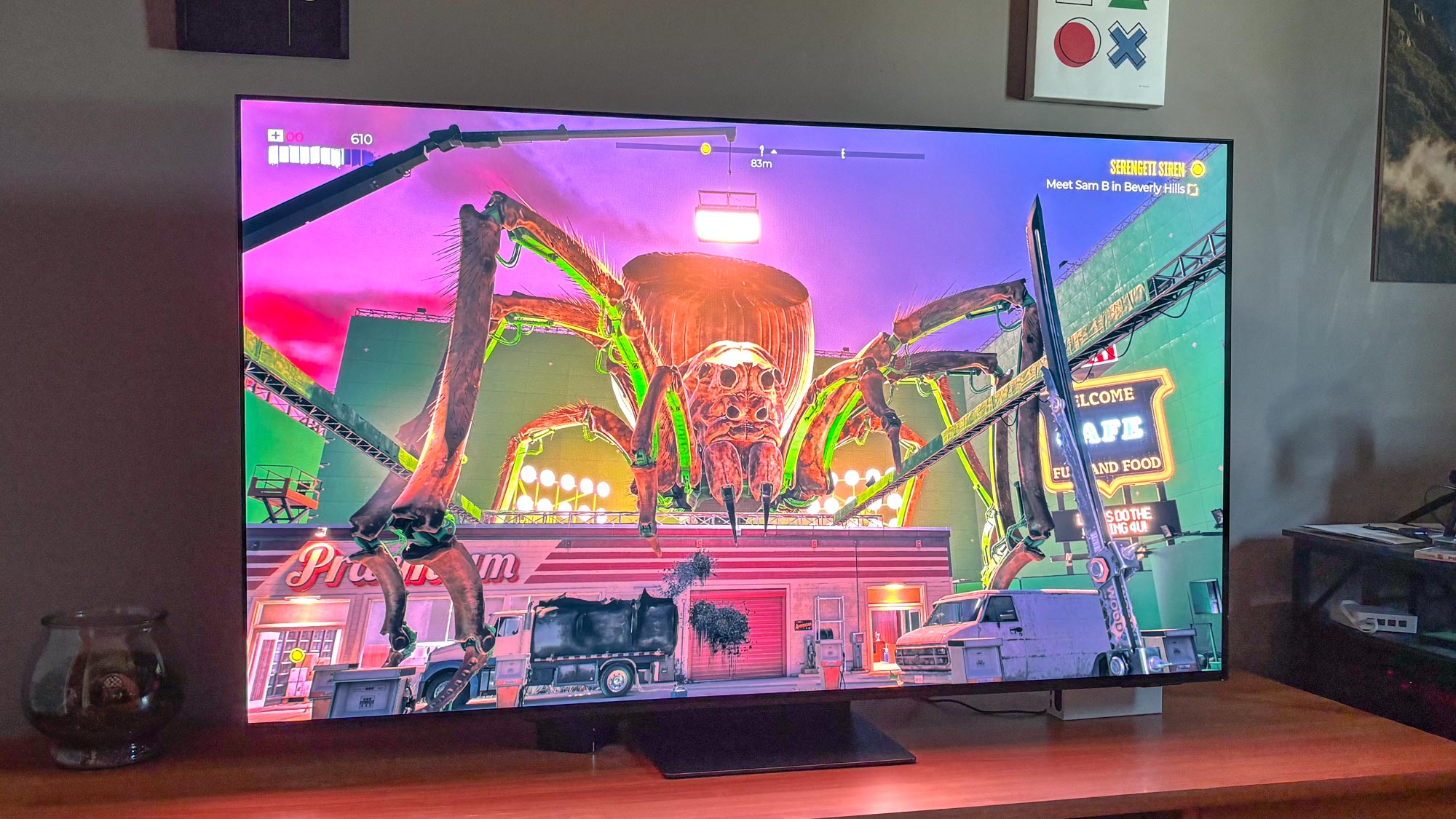
It’s missing Dolby Vision support like every other Samsung TV, but that’s almost made up for by features like the Samsung Game Bar and Eye Comfort modes. It’s still a bummer not playing games on Xbox Series X at their best possible HDR settings, but it’s less of a sting when the tradeoff is input latency of 9.2ms, far faster than almost any of its competitors.
Samsung S95D OLED review: Smart features
Samsung TVs all use the Tizen smart platform, and the S95D is no different. It's not exactly minimalist with its many rows of content suggestions, Daily+ home screen that combines SmartThings and Samsung Health information and the aforementioned Game Hub, but it is pragmatically designed. Finding the right settings in this year’s iteration of Tizen is much easier, and there’s even a built-in trouble-shooter that you can ask for help if you don’t know where something is located in the user interface.
As you’d expect, all of the major streaming apps are here and accounted for — but any of the ones not installed by default will require you to make a Samsung account to download. That can be relatively annoying, especially if you hate creating another account for a platform you’re not going to use all that often, but at least it’s a one-time thing and you won’t be logged out every time you start up the TV.
To keep recommendations age appropriate, Tizen does allow for multiple accounts on the same TV. That way, your kids aren’t getting recommendations for the latest TV-MA HBO blockbuster and you won’t have to get yet another reminder to watch their favorite Disney film.
Samsung S95D OLED review: Remote
The Samsung S95D ships with the simple — but environmentally friendly — Eco Remote that charges off solar power. Leave it flipped over when it’s not in use and you’ll never need to worry about replacing the batteries. It’s a wonderful solution to the ever-growing problem of e-waste, though the remote itself is a bit sparse compared to the ones used by LG and Sony.
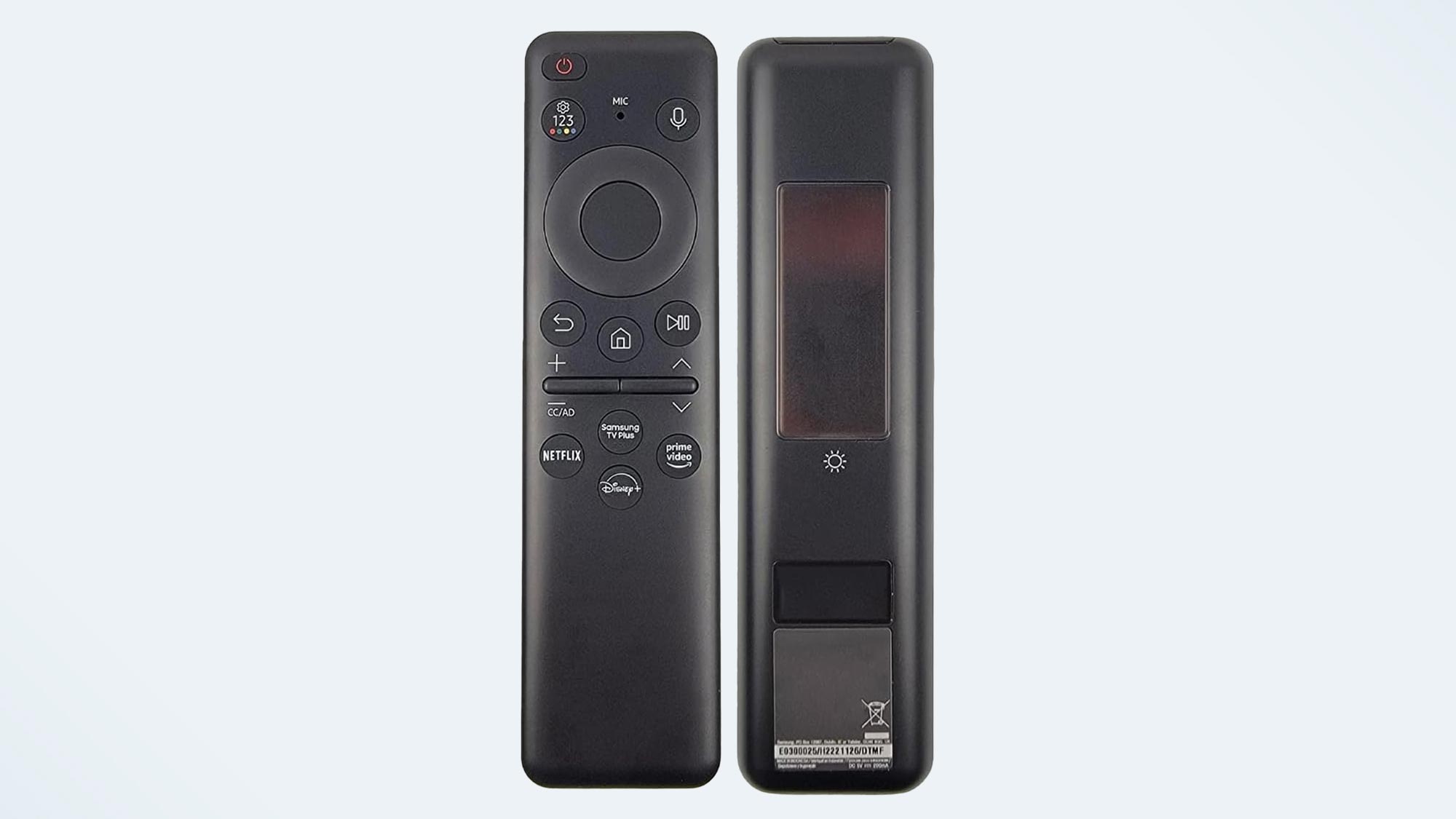
Of note on the remote are its four quick access buttons to Netflix, Disney Plus, Prime Video and Samsung’s own TV Plus service as well as a built-in microphone. For virtual assistants, the S95D has the choice of Amazon Alexa or Bixby, both of which can be used hands-free or via the remote depending on how much privacy you’re looking for.
For my testing I picked Bixby (this is a Samsung TV after all) and I didn’t hate the experience. Some queries are still misunderstood by the smart assistant, but eventually Bixby understood what I meant. Would I go back and choose Alexa instead? Oh, absolutely. But it’s always nice to have a few choices…even if one of those options is Bixby.
Samsung S95D OLED review: Verdict
The Samsung S95D OLED is an engineering marvel and its test results speak for themselves. Its top-tier color performance, plus Samsung’s work on the processor and the anti-glare coating on this QD-OLED make it one of the best-designed TVs I’ve seen in years. Yes, there’s a large sticker price attached to it, but I think it’s one that will feel justified to most people.
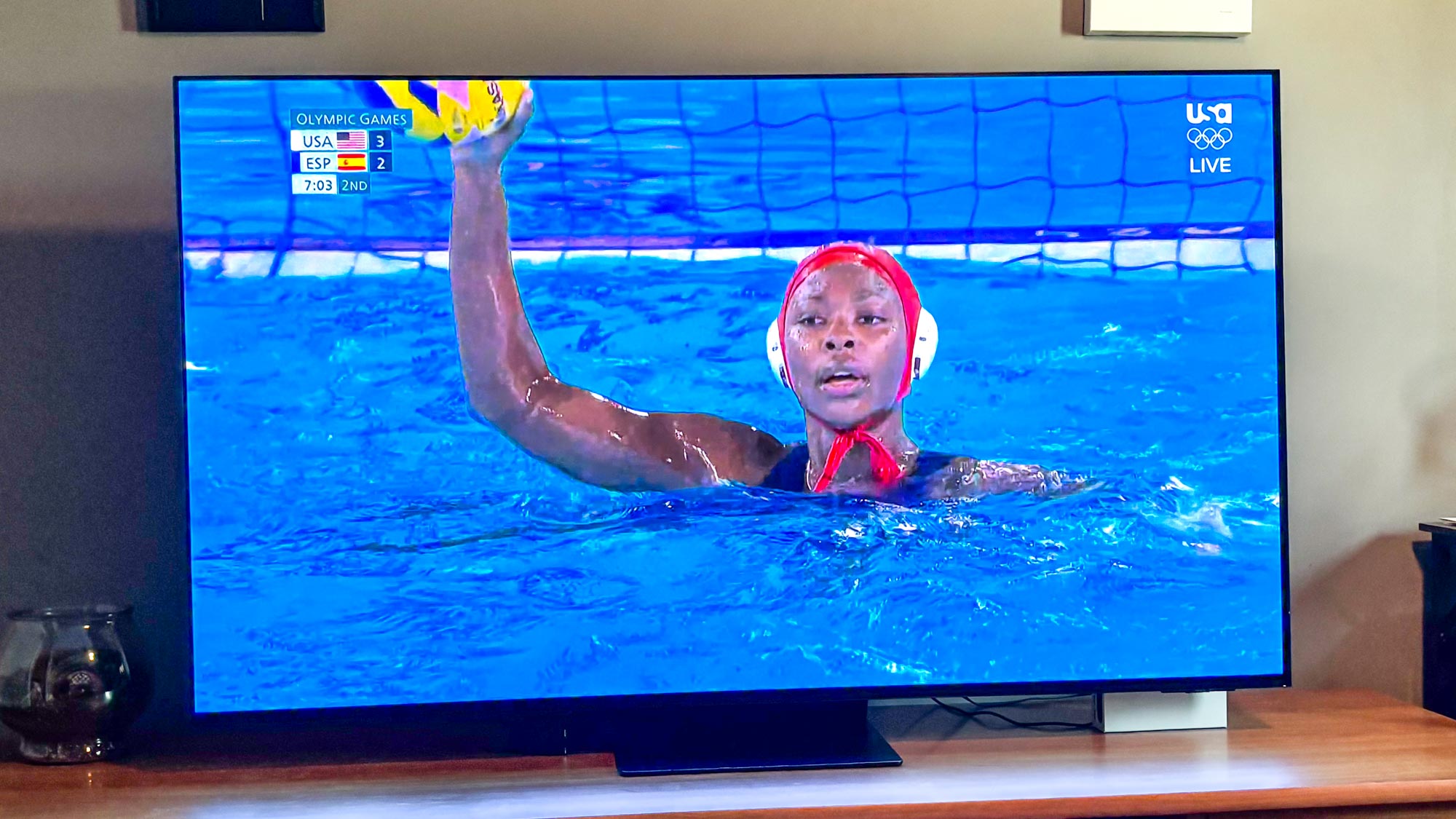
Here’s where things are hairy, though. With AI processing turned on, you’re not guaranteed a consistently impressive picture. Some scenes will absolutely blow you away, while others are going to leave you scratching your head why colors and background objects look the way they look. With AI processing turned off, you’re going to miss out on many jaw-dropping images but performance will at least be more consistent with OLED TVs you might’ve owned in the past.
Given the intensity of the competition this year from the LG G4 OLED and Sony Bravia 9, it’s hard to say that the S95D is in a league of its own. Yes, its color volume and contrast are far better than the competition, but screens like the Hisense U8N deliver a bit more bang for your buck. That said, similar TVs from Sony and LG that are around this sticker price might not reach the same highs, but rarely reach the same lows (however infrequent those may be).
Is the Samsung S95D OLED one of the best OLED TVs of 2024? Yes, absolutely, and I think most folks are going to feel the same way when they see it for themselves. But, is it also possible that the TV’s over-processing is going to upset some picture purists out there? You bet. Regardless of what we feel about the S95D right now, however, it’s undeniable that the S95D’s innovations lay the groundwork for even more impressive QD-OLEDs in the next year or two.






